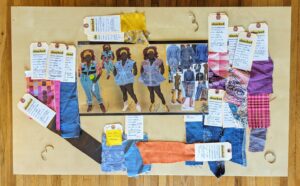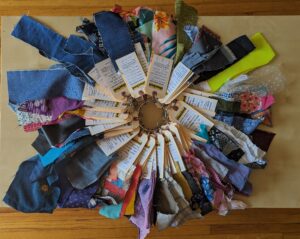
Caity Mulkearns ’10 is as an associate designer for “Shucked,” a Broadway production.
The Lead On, Creatively series highlights TCU College of Fine Arts alumni, students and faculty who are putting their passion into practice.
We spoke to Caity Mulkearns ’10 about her successful career in the performing arts and advice to emerging costume designers. She serves as an associate designer for “Shucked,” a Broadway production.
An Eye for Design
Mulkearns’ remarkable journey has taken her from small-scale productions to the dazzling lights of Broadway. Along her path, she has collaborated with renowned costume designer Angela Wendt on the acclaimed musical “Rent.”
For Mulkearns, the most rewarding projects are the ones that challenge her diverse skill set. She had the opportunity to explore and integrate LEDs into costumes for the production of “Other World,” with a keen focus on both storytelling and actor safety.
In her role as associate designer, Mulkearns adapts to the specific needs of the lead designer. Typically, the costume designer’s process begins with research and discussions involving the director, fellow designers and the cast. Mulkearns then helps to create the production’s blueprint, but her primary work begins when sketches are approved by the producers and director.
“Each process is different, but turning sketches into reality involves a lot of creativity – aesthetically and logistically.”
Designing on Broadway
Mulkearns has formed a decade-long partnership with Tilly Grimes, the costume designer for “Shucked.” The duo created two sets of costumes for the production, with the initial wardrobe completed in fall 2022.

“Shucked” fabric swatches with sketches by costume designer Tilly Grimes. Photo credit: Tilly Grimes
Mulkearns and Grimes completed three weeks of pre-rehearsal work in New York City before transitioning to Salt Lake City for the production, where most items were purchased off the rack and then customized as needed for the show.
“It was a whirlwind of activity: sourcing, fitting, reshopping, pinning, returns and packing – all crammed into a rather compact space,” explains Mulkearns. “Once we arrived in Utah, we had the luxury of a dedicated costume shop for any necessary builds, alterations and crafts work.”
During the two weeks when the show was running, it became clear that the costumes would need a transformation on the way to Broadway.
Grimes redrew the show, creating a built version where most costumes are made from scratch, allowing for functional customization.

“Shucked” fabric ring. Photo credit: Tilly Grimes
With the newly approved sketches in hand, Mulkearns divided them into design packets to be sent to costume shops in New York City, kickstarting the bid process. During this phase, costume shops express their availability and interest in particular costumes, along with cost estimates.
“We worked with over 15 individual shops and artisans to build the characters, including creating custom fabrics, embroidery, screen printing and hand painting. The items were then distressed and worn in.”
Mulkearns led a full-time team of four throughout the process, with her schedule filled with fittings, fabric sourcing, logistics and more.
“It was a busy 10 weeks building up to tech, with another five weeks of tech and previews where we added and changed costumes and musical numbers before the opening,” she explains. “With new cast members coming in, my time with ‘Shucked’ still hasn’t ended.”
Q&A with Mulkearns
What skills from TCU have been most helpful in your career?
Proficiency in accounting and Excel – at the end of the day theater is still show business. Whether you work with a nonprofit or a commercial producer, budgets are the predominant topic.
Theater TCU Costume Studio Manager Michele Alford has a motto that has drilled itself into my soul, “Set yourself up for success.” Taking the time to find the best way to achieve goals for myself, the team, hired vendors, actors, wardrobe and the show ensures everyone’s satisfaction. This process supports my confidence when making requests.
What advice would you give students entering the field of costume design?
- Success and progress are non-linear.
- Don’t be precious about your work. The ultimate goal is to support the narrative in a clear way.
- Try not to say No – it stops the conversation. Instead give options for what you would need to accomplish what’s being asked whether that is additional funds, labor or time. If you manage expectations, you’ll always deliver.
What’s next for you?
My next project is the world premiere of “I Need That” by Theresa Rebeck, starring Danny DeVito on Broadway.
